2009 DODGE DAKOTA check engine
[x] Cancel search: check enginePage 13 of 449
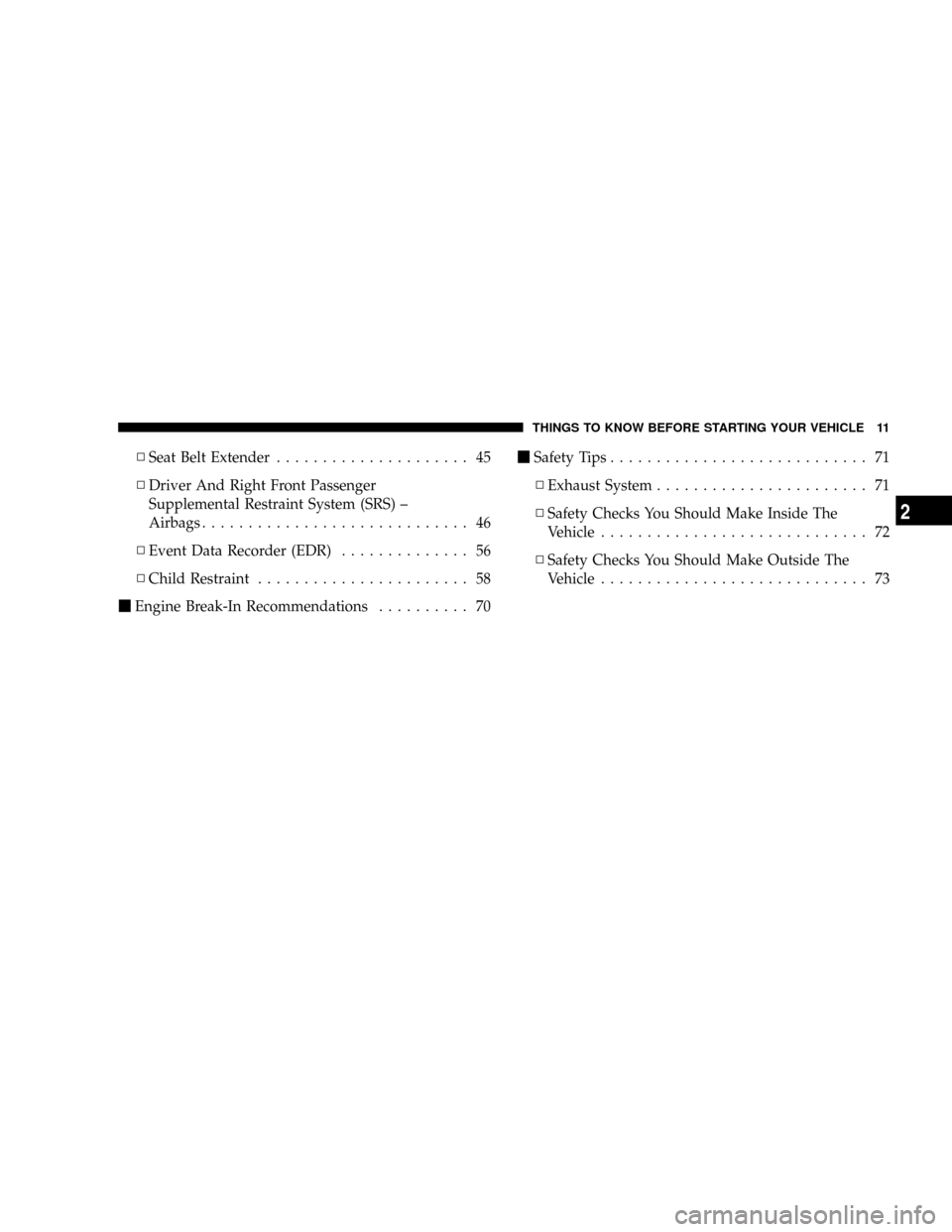
NSeat Belt Extender..................... 45
NDriver And Right Front Passenger
Supplemental Restraint System (SRS) ±
Airbags............................. 46
NEvent Data Recorder (EDR).............. 56
NChild Restraint....................... 58
mEngine Break-In Recommendations.......... 70mSafety Tips............................ 71
NExhaust System....................... 71
NSafety Checks You Should Make Inside The
Vehicle............................. 72
NSafety Checks You Should Make Outside The
Vehicle............................. 73
THINGS TO KNOW BEFORE STARTING YOUR VEHICLE 11
2
Page 18 of 449
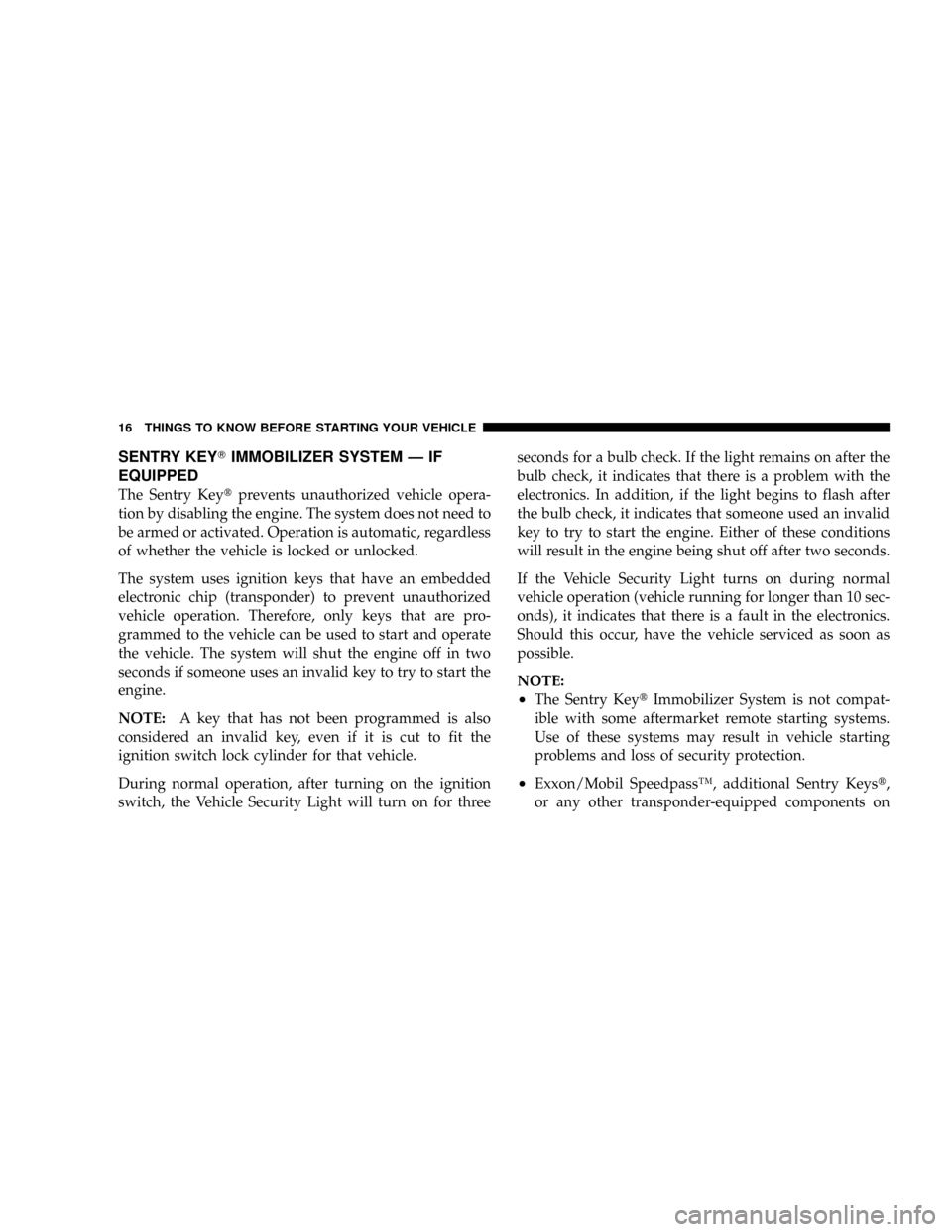
SENTRY KEYTIMMOBILIZER SYSTEM Ð IF
EQUIPPED
The Sentry Keytprevents unauthorized vehicle opera-
tion by disabling the engine. The system does not need to
be armed or activated. Operation is automatic, regardless
of whether the vehicle is locked or unlocked.
The system uses ignition keys that have an embedded
electronic chip (transponder) to prevent unauthorized
vehicle operation. Therefore, only keys that are pro-
grammed to the vehicle can be used to start and operate
the vehicle. The system will shut the engine off in two
seconds if someone uses an invalid key to try to start the
engine.
NOTE:A key that has not been programmed is also
considered an invalid key, even if it is cut to fit the
ignition switch lock cylinder for that vehicle.
During normal operation, after turning on the ignition
switch, the Vehicle Security Light will turn on for threeseconds for a bulb check. If the light remains on after the
bulb check, it indicates that there is a problem with the
electronics. In addition, if the light begins to flash after
the bulb check, it indicates that someone used an invalid
key to try to start the engine. Either of these conditions
will result in the engine being shut off after two seconds.
If the Vehicle Security Light turns on during normal
vehicle operation (vehicle running for longer than 10 sec-
onds), it indicates that there is a fault in the electronics.
Should this occur, have the vehicle serviced as soon as
possible.
NOTE:
²The Sentry KeytImmobilizer System is not compat-
ible with some aftermarket remote starting systems.
Use of these systems may result in vehicle starting
problems and loss of security protection.
²Exxon/Mobil SpeedpassŸ, additional Sentry Keyst,
or any other transponder-equipped components on
16 THINGS TO KNOW BEFORE STARTING YOUR VEHICLE
Page 21 of 449
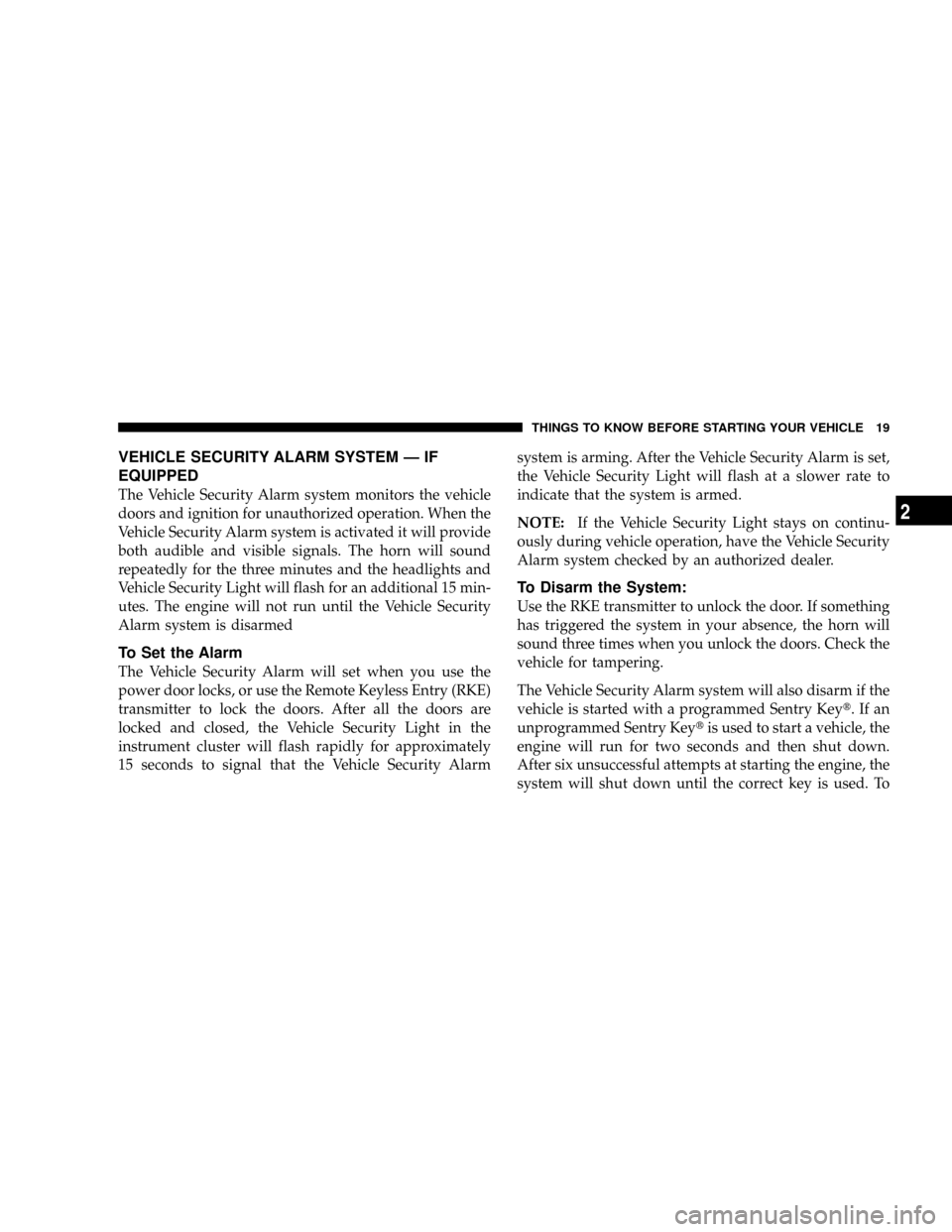
VEHICLE SECURITY ALARM SYSTEM Ð IF
EQUIPPED
The Vehicle Security Alarm system monitors the vehicle
doors and ignition for unauthorized operation. When the
Vehicle Security Alarm system is activated it will provide
both audible and visible signals. The horn will sound
repeatedly for the three minutes and the headlights and
Vehicle Security Light will flash for an additional 15 min-
utes. The engine will not run until the Vehicle Security
Alarm system is disarmed
To Set the Alarm
The Vehicle Security Alarm will set when you use the
power door locks, or use the Remote Keyless Entry (RKE)
transmitter to lock the doors. After all the doors are
locked and closed, the Vehicle Security Light in the
instrument cluster will flash rapidly for approximately
15 seconds to signal that the Vehicle Security Alarmsystem is arming. After the Vehicle Security Alarm is set,
the Vehicle Security Light will flash at a slower rate to
indicate that the system is armed.
NOTE:If the Vehicle Security Light stays on continu-
ously during vehicle operation, have the Vehicle Security
Alarm system checked by an authorized dealer.
To Disarm the System:
Use the RKE transmitter to unlock the door. If something
has triggered the system in your absence, the horn will
sound three times when you unlock the doors. Check the
vehicle for tampering.
The Vehicle Security Alarm system will also disarm if the
vehicle is started with a programmed Sentry Keyt.Ifan
unprogrammed Sentry Keytis used to start a vehicle, the
engine will run for two seconds and then shut down.
After six unsuccessful attempts at starting the engine, the
system will shut down until the correct key is used. To
THINGS TO KNOW BEFORE STARTING YOUR VEHICLE 19
2
Page 27 of 449
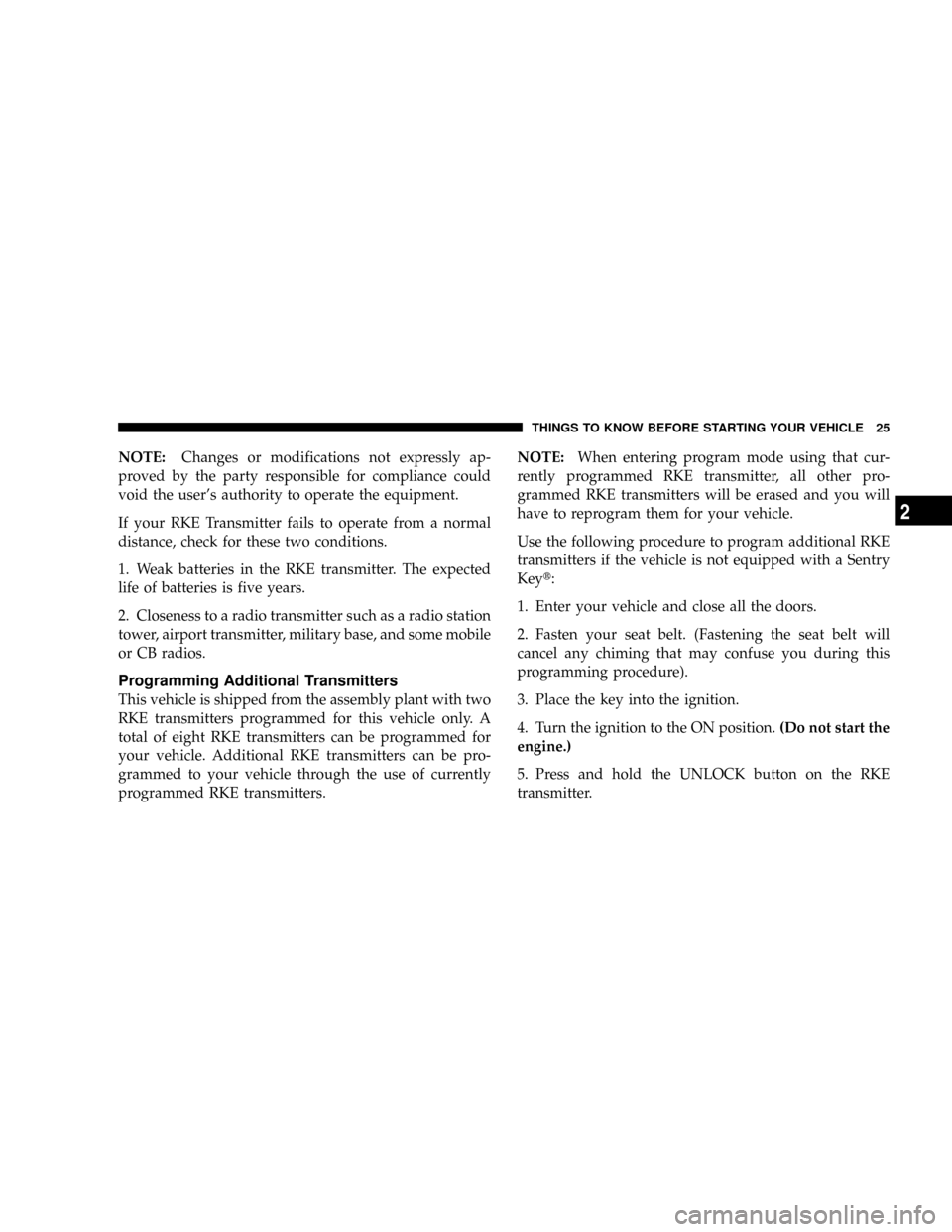
NOTE:Changes or modifications not expressly ap-
proved by the party responsible for compliance could
void the user's authority to operate the equipment.
If your RKE Transmitter fails to operate from a normal
distance, check for these two conditions.
1. Weak batteries in the RKE transmitter. The expected
life of batteries is five years.
2. Closeness to a radio transmitter such as a radio station
tower, airport transmitter, military base, and some mobile
or CB radios.
Programming Additional Transmitters
This vehicle is shipped from the assembly plant with two
RKE transmitters programmed for this vehicle only. A
total of eight RKE transmitters can be programmed for
your vehicle. Additional RKE transmitters can be pro-
grammed to your vehicle through the use of currently
programmed RKE transmitters.NOTE:When entering program mode using that cur-
rently programmed RKE transmitter, all other pro-
grammed RKE transmitters will be erased and you will
have to reprogram them for your vehicle.
Use the following procedure to program additional RKE
transmitters if the vehicle is not equipped with a Sentry
Keyt:
1. Enter your vehicle and close all the doors.
2. Fasten your seat belt. (Fastening the seat belt will
cancel any chiming that may confuse you during this
programming procedure).
3. Place the key into the ignition.
4. Turn the ignition to the ON position.(Do not start the
engine.)
5. Press and hold the UNLOCK button on the RKE
transmitter.
THINGS TO KNOW BEFORE STARTING YOUR VEHICLE 25
2
Page 170 of 449
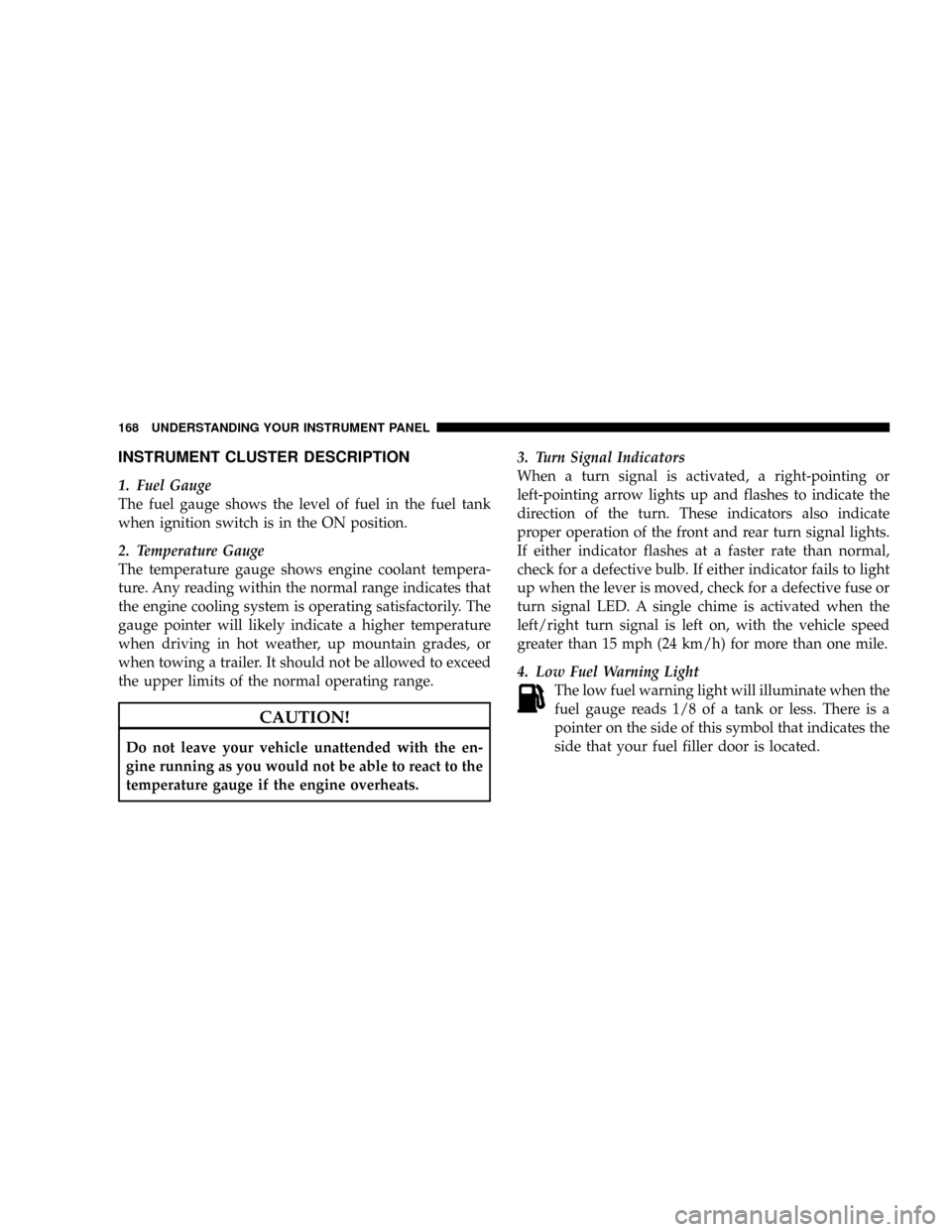
INSTRUMENT CLUSTER DESCRIPTION
1. Fuel Gauge
The fuel gauge shows the level of fuel in the fuel tank
when ignition switch is in the ON position.
2. Temperature Gauge
The temperature gauge shows engine coolant tempera-
ture. Any reading within the normal range indicates that
the engine cooling system is operating satisfactorily. The
gauge pointer will likely indicate a higher temperature
when driving in hot weather, up mountain grades, or
when towing a trailer. It should not be allowed to exceed
the upper limits of the normal operating range.
CAUTION!
Do not leave your vehicle unattended with the en-
gine running as you would not be able to react to the
temperature gauge if the engine overheats.3. Turn Signal Indicators
When a turn signal is activated, a right-pointing or
left-pointing arrow lights up and flashes to indicate the
direction of the turn. These indicators also indicate
proper operation of the front and rear turn signal lights.
If either indicator flashes at a faster rate than normal,
check for a defective bulb. If either indicator fails to light
up when the lever is moved, check for a defective fuse or
turn signal LED. A single chime is activated when the
left/right turn signal is left on, with the vehicle speed
greater than 15 mph (24 km/h) for more than one mile.
4. Low Fuel Warning Light
The low fuel warning light will illuminate when the
fuel gauge reads 1/8 of a tank or less. There is a
pointer on the side of this symbol that indicates the
side that your fuel filler door is located.
168 UNDERSTANDING YOUR INSTRUMENT PANEL
Page 171 of 449
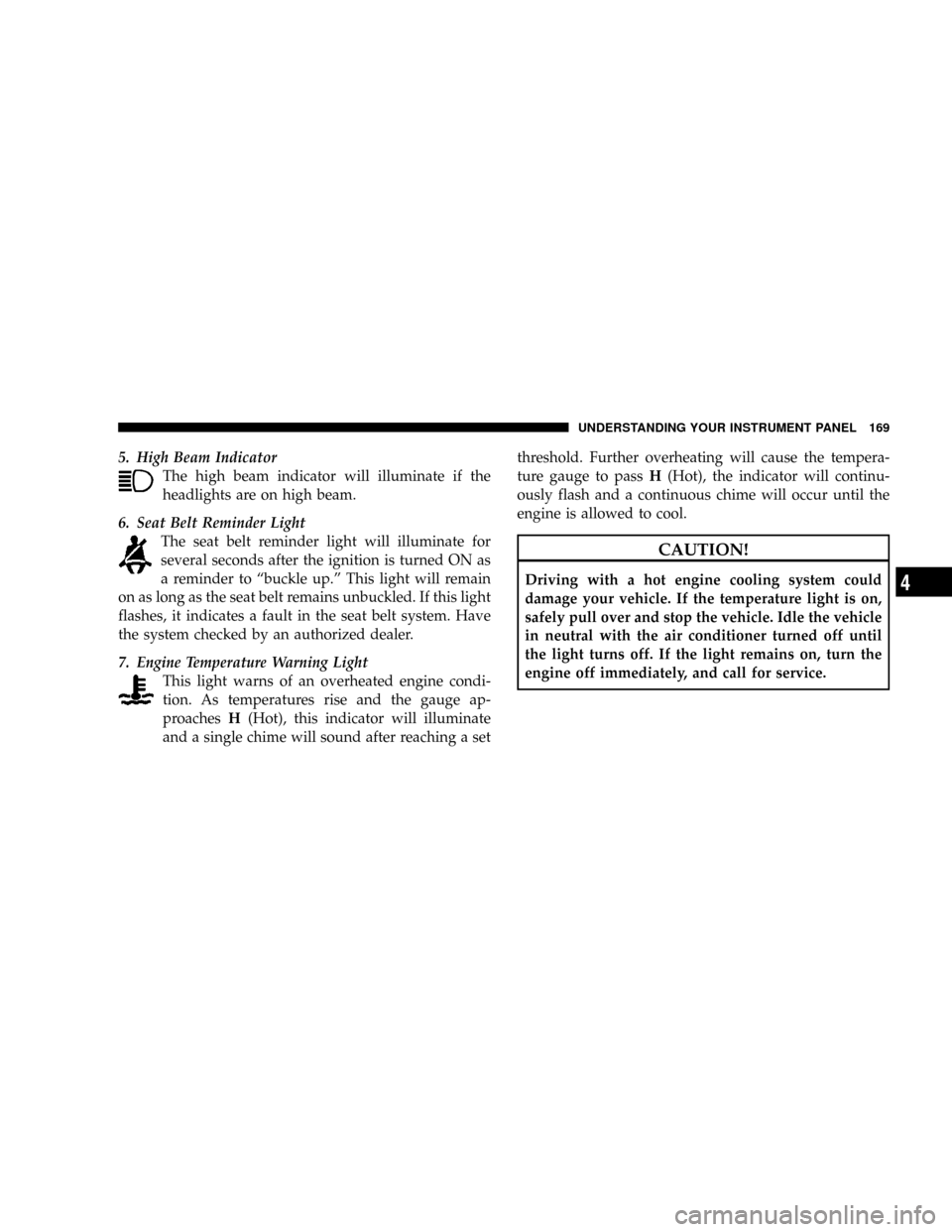
5. High Beam Indicator
The high beam indicator will illuminate if the
headlights are on high beam.
6. Seat Belt Reminder Light
The seat belt reminder light will illuminate for
several seconds after the ignition is turned ON as
a reminder to ªbuckle up.º This light will remain
on as long as the seat belt remains unbuckled. If this light
flashes, it indicates a fault in the seat belt system. Have
the system checked by an authorized dealer.
7. Engine Temperature Warning Light
This light warns of an overheated engine condi-
tion. As temperatures rise and the gauge ap-
proachesH(Hot), this indicator will illuminate
and a single chime will sound after reaching a setthreshold. Further overheating will cause the tempera-
ture gauge to passH(Hot), the indicator will continu-
ously flash and a continuous chime will occur until the
engine is allowed to cool.
CAUTION!
Driving with a hot engine cooling system could
damage your vehicle. If the temperature light is on,
safely pull over and stop the vehicle. Idle the vehicle
in neutral with the air conditioner turned off until
the light turns off. If the light remains on, turn the
engine off immediately, and call for service.
UNDERSTANDING YOUR INSTRUMENT PANEL 169
4
Page 172 of 449
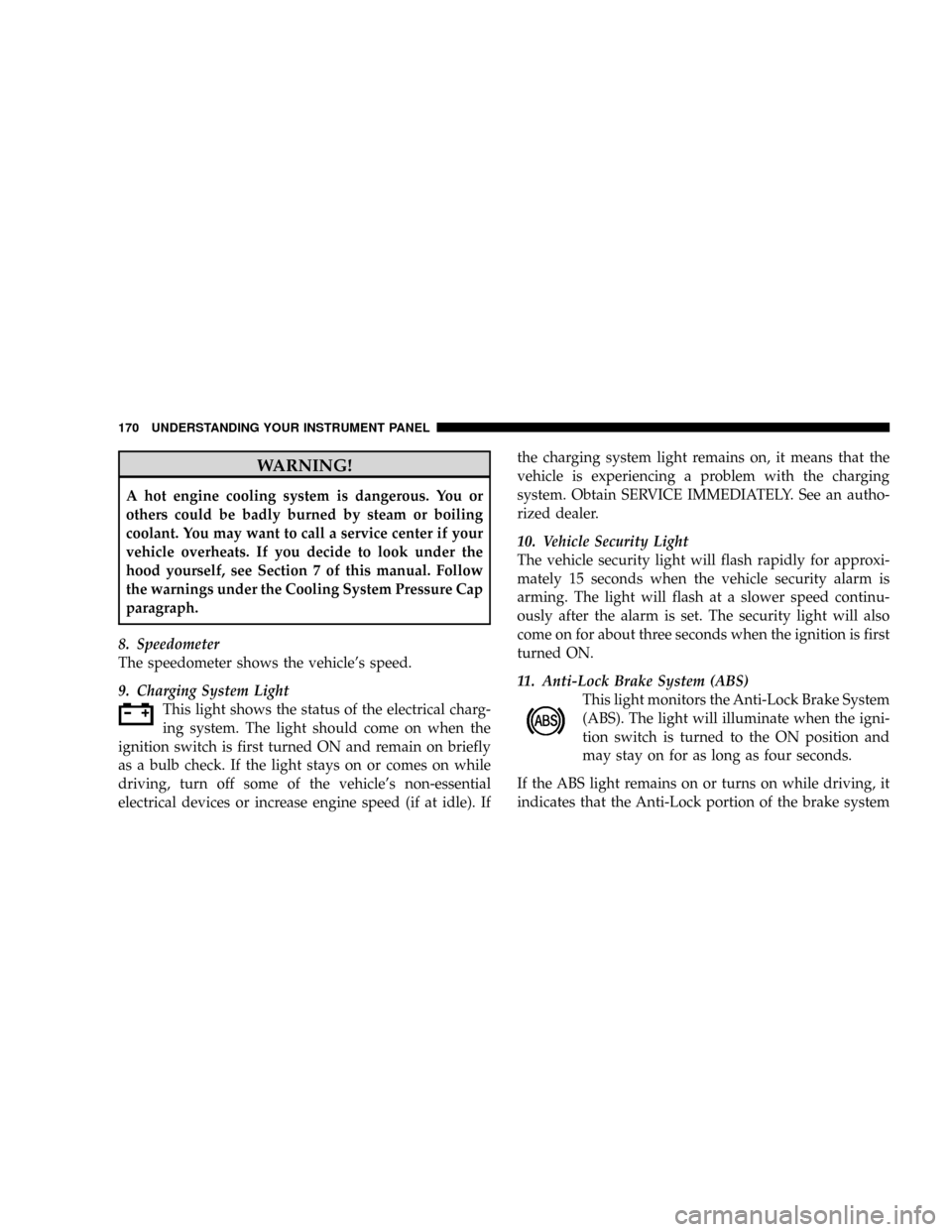
WARNING!
A hot engine cooling system is dangerous. You or
others could be badly burned by steam or boiling
coolant. You may want to call a service center if your
vehicle overheats. If you decide to look under the
hood yourself, see Section 7 of this manual. Follow
the warnings under the Cooling System Pressure Cap
paragraph.
8. Speedometer
The speedometer shows the vehicle's speed.
9. Charging System Light
This light shows the status of the electrical charg-
ing system. The light should come on when the
ignition switch is first turned ON and remain on briefly
as a bulb check. If the light stays on or comes on while
driving, turn off some of the vehicle's non-essential
electrical devices or increase engine speed (if at idle). Ifthe charging system light remains on, it means that the
vehicle is experiencing a problem with the charging
system. Obtain SERVICE IMMEDIATELY. See an autho-
rized dealer.
10. Vehicle Security Light
The vehicle security light will flash rapidly for approxi-
mately 15 seconds when the vehicle security alarm is
arming. The light will flash at a slower speed continu-
ously after the alarm is set. The security light will also
come on for about three seconds when the ignition is first
turned ON.
11. Anti-Lock Brake System (ABS)
This light monitors the Anti-Lock Brake System
(ABS). The light will illuminate when the igni-
tion switch is turned to the ON position and
may stay on for as long as four seconds.
If the ABS light remains on or turns on while driving, it
indicates that the Anti-Lock portion of the brake system
170 UNDERSTANDING YOUR INSTRUMENT PANEL
Page 173 of 449
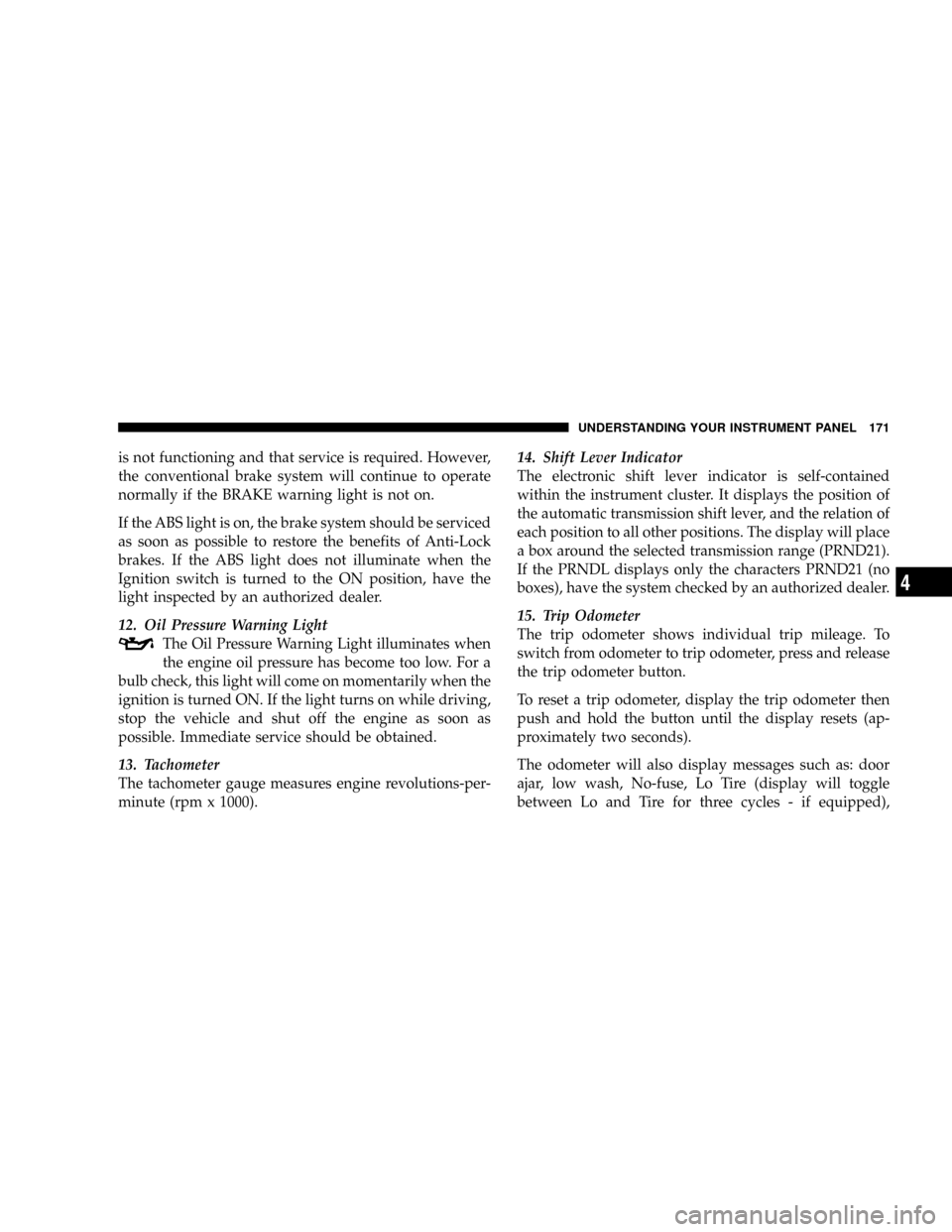
is not functioning and that service is required. However,
the conventional brake system will continue to operate
normally if the BRAKE warning light is not on.
If the ABS light is on, the brake system should be serviced
as soon as possible to restore the benefits of Anti-Lock
brakes. If the ABS light does not illuminate when the
Ignition switch is turned to the ON position, have the
light inspected by an authorized dealer.
12. Oil Pressure Warning Light
The Oil Pressure Warning Light illuminates when
the engine oil pressure has become too low. For a
bulb check, this light will come on momentarily when the
ignition is turned ON. If the light turns on while driving,
stop the vehicle and shut off the engine as soon as
possible. Immediate service should be obtained.
13. Tachometer
The tachometer gauge measures engine revolutions-per-
minute (rpm x 1000).14. Shift Lever Indicator
The electronic shift lever indicator is self-contained
within the instrument cluster. It displays the position of
the automatic transmission shift lever, and the relation of
each position to all other positions. The display will place
a box around the selected transmission range (PRND21).
If the PRNDL displays only the characters PRND21 (no
boxes), have the system checked by an authorized dealer.
15. Trip Odometer
The trip odometer shows individual trip mileage. To
switch from odometer to trip odometer, press and release
the trip odometer button.
To reset a trip odometer, display the trip odometer then
push and hold the button until the display resets (ap-
proximately two seconds).
The odometer will also display messages such as: door
ajar, low wash, No-fuse, Lo Tire (display will toggle
between Lo and Tire for three cycles - if equipped),
UNDERSTANDING YOUR INSTRUMENT PANEL 171
4